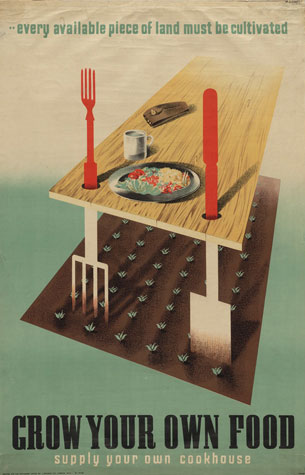 |
| Image via MoMa |
I exaggerate only to illustrate that the idea of gardening "every available piece of land" is a lot more romantic and grandiose than the practicalities of doing it. The poster's second statement-- GROW YOUR OWN FOOD-- implies that one should grow the food on YOUR OWN LAND (if you are so lucky to have access to some).
As it so happens, if you're privileged enough to have a house, chances are you do have access to land. We North Americans have a deep rooted (oh, that pun) love of the lawn. Artist Fritz Haeg has made a fine body of work "attacking the front lawn" (called Edible Estates) and transforming the traditional grass-blanket lawns of select families into homeowner-association-friendly edible landscapes. It's one thing to tear out a chunk of sod, mix in some compost, and grow some tomatoes for a season, it's a more impressive feat to overhaul the entire yard in such a way that property-value-sensitive neighbors aren't going to complain about your unruly Eden. In the Edible Estates book, Haeg taps a well-researched essay by Michael Pollan in which he outlines the historic precedents and chemical costs of our love of lawn.
If you've got a front lawn (or your apartment complex does) and are thinking about pushing some edible landscaping on your housemates/landlord/whomever, I recommend Haeg's book both for it's aesthetic sensibilities and it's infectious enthusiasm. Now's the time to start planning and between Haeg's work and the seed catalogs arriving by mail, you should have more inspiration than you do arable land. Go forth and "supply your own cookhouse."
No comments:
Post a Comment